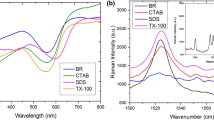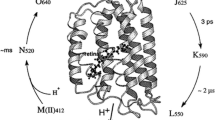Abstract
This review presents the results of studies concerning some factors that affect the process of photoinduced hydroxylaminolysis (PHA) in bacteriorhodopsin (BR) and different BR-based media. We consider the peculiar properties of the PHA reaction in water suspensions of BR and BR-based media depending on variation in PHA ingredients, and in particular the use of O-substituted hydroxylamines instead of hydroxylamine hydrochloride. In addition, we discuss how such factors as preliminary ultra-sonication affect the reaction of PHA in the course of BR bleaching and following the reconstitution of bacterioopsin. All the results are considered from the viewpoint of improving the performance of BR-based media as photosensitive materials for the processing and storage of optical information.




Similar content being viewed by others
References
Birge RR (1990) Photophysics and molecular electronic applications of the rhodopsins. Rev Phys Chem Soc 41:683–733
Birge RR, Gillespie NB, Izaguirre EW, Kusnetzow A, Lawrence AF, Singh D, Song Q, Schmidt E, Stuart JA, Seetharaman S, Wise K (1999) Biomolecular electronics: protein-based associative processors and volumetric memories. J Phys Chem B 103(49):10746–10766
Druzhko A (2009) Optical characteristics of polymer films based on bacteriorhodopsin for irreversible recording of optical information. Photochem Photobiol 85:614–616
Druzhko AB, Dyukova TV (2011) Phototransformations of bacteriorhodopsin and its derivatives in polymer matrices. Trends Photochem Photobiol 13:13–24
Druzhko AB, Pirutin SK (2014) Preliminary ultra-sonication affects the rate of the bacteriorhodopsin bleaching and the effectiveness of the reconstitution process in bacterioopsin. Photochem Photobiol 90:1207–1210
Druzhko A, Weetall H (1997) Photoinduced transformation of wild-type and D96N mutant 4-keto-bacteriorhodopsin gelatin films. Thin Solid Films 293:281–284
Druzhko A, Zharmukhamedov S, Vsevolodov N (1986) Photoinduced transformation of 4-keto-bacteriorhodopsin in polymeric matrices (In Russian). Biofizika 31:227–230
Druzhko A, Chamorovsky S, Lukashev Eu, Kononenko N, Vsevolodov N (1995) 4-keto-bacteriorhodopsin films as a promising photochromic and electrochromic biological material. Biosystem 35:129–132
Dyukova T, Druzhko A (2010) Peculiar properties of photoinduced hydroxylaminolysis in different bacteriorhodopsin-based media using O-substituted hydroxylamines. Photochem Photobiol 86:1255–1259
Dyukova T, Vsevolodov N (1996) Photochromic composition and materials containing bacteriorhodopsin. US Patent No. 5,518,858
Ernst OP, Lodowski DT, Elstner M, Hegemann P, Brown LS, Kandori H (2014) Microbial and animal rhodopsins: structures, functions, and molecular mechanism. Chem Rev 114:126–163
Ganea C, Gergely C, Ludmann K, Varo G (1997) The role of water in the extracellular half channel of bacteriorhodopsin. Biophys J 73:2718–2725
Gillespie NB, Wise KJ, Ren L, Stuart JA, Marcy DL, Hillebrecht J, Li Q, Ramos L, Jordan K, Fyvie S, Birge RR (2002) Characterization of the branched-photocycle intermediates P and Q of bacteriorhodopsin. J Phys Chem B 106(51):13352–13361
Grote M, Engelhard M, Hegemann P (2014) Of ion pumps, sensors and channels—perspectives on microbial rhodopsins between science and history. Biochim Biophys Acta 1837:533–545
Hampp N (2000) Bacteriorhodopsin as a photochromic retinal protein for optical memory. Chem Rev 100:1755–1776
Hirai T, Subramaniam S, Lanyi JK (2009) Structural snapshots of conformational changes in a seven-helix membrane protein: lessons from bacteriorhodopsin. Curr Opin Struct Biol 19:433–439
Korchemskaya E Ya, Stepanchikov DA, Druzhko AB, Dyukova TV (1999) Mechanisms of nonlinear photoinduced anisotropy in bacteriorhodopsin and its derivatives. J Biol Phys (Cluver Press) 24:201–215
Korchemskaya E, Stepanchikov D, Dyukova T (2000) Photoinduced anisotropy in chemically-modified films of bacteriorhodopsin and its genetic mutants. Opt Mater 14(2):185–191
Mahyad B, Janfaza S, Hosseini E (2015) Bio-nano hybrid materials based on bacteriorhodopsin: potential applications and future strategies. Adv Colloid Interface Sci 225:194–202
Mitsner B, Khodonov A, Zvonkova E, Evstigneeva R (1985) Analogues of retinal: synthesis and interaction with bacterioopsin (in Russian). Bioorg Chem (Moscow) 12:5–53
Oesterhelt D, Schumann L (1974) Reconstitution of bacteriorhodopsin. FEBS Lett 44:262–265
Oesterhelt D, Schumann L, Gruber H (1974) Light-dependent reaction of bacteriorhodopsin with hydroxylamine in cell suspensions of Halobacterium halobium: demonstration of an apomembrane. FEBS Lett 44:257–261
Ranaghan MJ, Greco JA, Wagner NL, Grewal R, Rangarajan R, Koscielecki JF, Wise KJ, Birge RR (2014) Photochromic bacteriorhodopsin mutant with high holographic efficiency and enhanced stability via a putative self-repair mechanism. ACS Appl Mater Interfaces 6(4):2799–2808
Renthal R, Perez MN (1982) Bleaching of purple membrane with O-substituted hydroxylamines. Photochem Photobiol 36:345–348
Rousso I, Gat Y, Sheves M, Ottolenghi M (1998) Effective light-induced hydroxylamine reactions occur with C13=C14 nonisomerasable bacteriorhodopsin pigments. Biophys J 75:413–417
Song QW, Gross RB, Chen Zh, Zhang Ch, Blumer R, Birge RR (1993) Chemically enhanced bacteriorhodopsin thin-film spatial light modulator. Opt Lett 18(16):1373–1375
Stepanchikov D, Burykin N, Dyukova T, Ebrey T, Balashov S, Korchemskaya E (2006) Bacteriorhodopsin and its mutants for light-induced anisotropy and dynamic holography recording. Funct Mater 13(4):669–675
Stuart JA, Marcy DL, Birge RR (2001) Photonic and optoelectronic applications of bacteriorhodopsin. In: Der A, Keszthelyi L (eds) Bioelectronic applications of photochromic pigments, IOS Press, pp 16–29
Stuart JA, Marcy DL, Wise KJ, Birge RR (2002) Volumetric optical memory based on bacteriorhodopsin. Synth Met 127(1–3):3–15
Subramaniam S, Marti T, Rosselet SJ, Rothschild KJ, Khorana G (1991) The reaction of hydroxylamine with bacteriorhodopsin studied with mutants that have altered photocycles: selective reactivity of different photointermediates. Proc Natl Acad Sci USA 88:2583–2587
Vsevolodov N (1998) Biomolecular electronics—an introduction via photosensitive proteins. Birkháuser, Boston
Vsevolodov N, Druzhko A, Dyukova T, Shakhbazyan V (1995) Optical recording material based on bacteriorhodopsin modified with hydroxylamine. SPIE 114:511–520
Wagner NL, Greco JA, Ranaghan MJ, Birge RR (2013a) Directed evolution of bacteriorhodopsin for application in bioelectronic. J R Soc Interface 15:20130197
Wagner NL, Greco JA, Ranaghan MJ, Birge RR (2013b) Directed evolution of bacteriorhodopsin for applications in bioelectronics. J R Soc Interface 10(84):20130197
Acknowledgments
Funding was provided by Federal Budget of RF (Grant no. 0117-2014-0005).
Author information
Authors and Affiliations
Corresponding author
Rights and permissions
About this article
Cite this article
Druzhko, A.B., Dyukova, T.V. & Pirutin, S.K. Some factors affecting the process of photoinduced hydroxylaminolysis in different bacteriorhodopsin-based media. Eur Biophys J 46, 509–515 (2017). https://doi.org/10.1007/s00249-017-1211-0
Received:
Revised:
Accepted:
Published:
Issue Date:
DOI: https://doi.org/10.1007/s00249-017-1211-0




